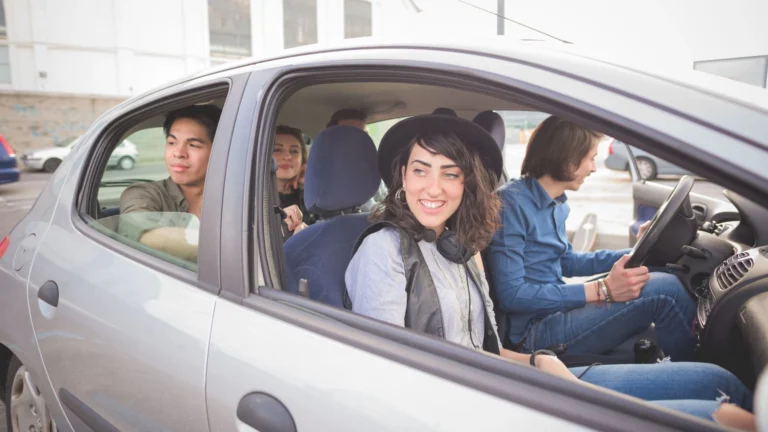As a student, moving from place to place isn’t cheap. The average college student spends about $1,200 on transportation annually. Whether you’re commuting to class, going home over the holidays, or traveling through new cities, those expenses add up quickly.
Good news! You have options to cut costs while reaching your destination. With smart choices, you can save on transportation without losing convenience.
Affordable options are critical for students who are balancing tuition, rent, and other expenses. Instead of spending on daily commutes that are expensive, look into public transport passes, share car rides with coworkers, or bike. You can also download transportation apps or look for discount fares. Many tricks can help save money on transportation.
For times when extra cash is needed, Blitz has your back. With instant cash advances up to $99, no credit checks, and no hidden fees, Blitz makes managing unexpected expenses easier.
This guide walks you through budget-friendly transportation options. Regardless of whether you’re commuting regularly or just taking some occasional trips, these strategies will help you save money while getting around.
Public Transport & Student Discounts
For college students, public transportation is a more affordable option. A good number of cities and campuses offer student transit discounts, which can help you reduce your travel costs in half. Students also have access to cheap alternatives in the form of buses, subways, and trains instead of expensive rideshares. Here’s how to save on transportation with public transit discounts.
Check for Student Transit Passes
Some cities provide student benefits on public transportation, sometimes up to fifty percent off. You may be eligible for a student transit pass through your campus transportation office or the local transit authority. It can massively cut down your day-to-day running costs.
Get the Monthly Passes
If you often use public transport, get a monthly or semester pass. It’s cheaper than buying single tickets. Daily fares can add up quickly. A discounted student pass can save you money in the long run.
Use Transit Apps
Transit, Moovit, and Citymapper are some applications that help students locate affordable and prompt routes. They also help with real-time scheduling, provide cheaper alternatives, and send service disruption notifications to save time and money.
Check if Your Student ID Offers Free Rides
Some universities have arrangements with certain local public transportation systems so that students can board for no charge or at a significantly reduced fare. Always ask your school administration or visit the school’s website to confirm if your student ID allows free or discounted transportation.
Search for Off-Peak Travel Discounts
Some public transit systems have reduced fares during less-traveled times. If you can, try to plan to travel during some of the less popular times that suit you; this will allow you to avoid the bus and train-crushing crowds around you.
Check this out: Best Budget-Friendly Travel Destinations for Students: Explore Without Overspending
Save on Gas & Ridesharing Costs
Transportation can be a significant financial burden to students, particularly if you use a car or rideshare service. But with some clever planning, you can save money on transportation without giving up convenience. Whether you drive your car or use Uber and Lyft often, these tips will help you save money and keep some cash in your pocket.
Use GasBuddy to Find Cheap Gas
Gas prices can differ drastically from station to station. GasBuddy helps you find the lowest prices near you so you never pay too much at the pump. Checking the app before refueling could save you hundreds a year.
Carpool Whenever Possible
If your friend or classmates are going the same way, carpooling can not only split gas costs but also reduce the wear and tear on your vehicle. Apps such as Waze Carpool help you find riders and reduce your costs.
Use Uber Pool & Lyft Line for Shared Rides
If you use Uber Pool or Lyft Line, you can share your ride with people going in the same direction instead of paying for a private trip. These companies have driven down your fare, reducing the cost of ridesharing for students.
Check if Your School Offers Rideshare Programs
A few universities have free or reduced rideshare programs for students. That can mean campus shuttles or things like partnerships with Uber and Lyft. Look first to your school’s transportation office for discounts before booking a ride.
Using these simple hacks will help you travel around at lower costs. So keep searching for more ways to travel smarter and make your student budget go further!
Cheap Long-Distance Travel Options
As a student, you have a wide variety of affordable transportation options available for traveling between cities or for going home for the holidays. If you know where to go for cheap student travel deals for buses, trains, or flights, you’ll save a ton. Here are some ways by which you can save on long-distance travel.
Megabus & Greyhound for Budget-Friendly Travel
For intercity travel on a budget,there’s Megabus and Greyhound. Fares sometimes go for as low as $1 if scheduled in advance. These buses run routes throughout the U.S., making them ideal for students looking for affordable long-distance travel.
Student Discounts on Flights
Airfare (especially if you’re flying internationally) can be expensive, but sites like StudentUniverse and Skyscanner often have exclusive student deals on domestic and international flights. BEFORE YOU BOOK: Always check these sites to get the best deals on airfare.
Book in Advance for the Best Prices
Whether it’s a bus, train, or airplane, booking ahead of time will always save you money. Often, low-priced options get costlier as the date draws near. As such, advanced preparation can save you a lot of cash.
Consider Flexible Travel Dates
If you can be flexible on when you travel, weekdays or off-peak season travel, it can bring costs down. Flights and bus fares tend to be cheaper on Tuesdays and Wednesdays, so in planning your trips, that is something to keep in mind.
These student transit hacks will help you travel long-distance without breaking the bank. Plan, get a discount, and find the cheapest way to travel.

Save on Car Maintenance & Insurance
Maintaining a good-fitting vehicle and finding good insurance options can help you to save hundreds of dollars every year. Here is how to save money on maintenance, insurance, car finance, and fuel if you’re a student with a car. Here are ways to save:
Keep Up with Regular Maintenance
Regular maintenance checkups boost fuel economy and prevent expensive repairs. Routine maintenance, such as oil changes, tire inflation, and air filter replacement, goes a long way. A properly maintained vehicle will have better road performance and a longer life, and, in the long term, it will help you spend less on gas and repairs.
Compare Car Insurance Rates
Car insurance is expensive, but several companies offer student discounts. Exactly, you may qualify for a student discount if you have good grades. It can also be a good idea to shop around for rates with different insurers so you get the best deal. Even tiny savings will aggregate over years.
Use Pay-Per-Mile Insurance
If you drive infrequently, look into pay-per-mile insurance. Companies such as Metromile charge you for the number of miles you drive instead of a set monthly rate. This can save students a lot of money if they only drive their car on occasion for errands or short trips.
Choose a Used or Fuel-Efficient Car
If you do have a car, get one that is fuel and maintenance-efficient. Used cars tend to be much less expensive than new ones and can be just as reliable if they’re well cared for.
Leverage Campus Resources
Many transportation options can save students money. Free shuttles, carpooling, and bike-sharing help reduce costs and make getting to work easier. Here are ways to use campus transportation services.
Use University-Sponsored Transportation
Most colleges also offer free shuttles to destinations such as shopping centers, train stations, and even airports. Taking these shuttles can save you money and the stress of driving. Visit your school’s website for schedules and routes.
Take Advantage of Public Transit Discounts
Numerous universities collaborate with local transit services to provide discounted or free student bus and train passes. Such passes can add up to substantial savings on commuting. Contact your school’s transportation office to see if you are eligible for student discounts on public transit.
Borrow or Rent a Bike
Some schools offer bike-sharing programs that let students borrow or rent a bike at little or no cost. One of the cheapest and greenest methods of transport on campus is provided by bikes. You also save gas and parking money and get some exercise.
Walk When Possible
Walking is the most affordable and healthiest means of transportation for traversing campus. Most college campuses are purposefully built to support walking and ensure classes, residence halls, and dining halls are within reach. Choosing to walk saves money on gas, parking fees, and transportation costs in the long run.
Read: How to Save Money on Travel as a Student Without Missing Out on the Fun?
Plan Your Trips Efficiently
One way you could save money on transportation is to plan your trips. You can make a single trip rather than making multiple smaller trips throughout the week. This approach reduces the number of miles you drive. It also saves you money on gas and minimizes wear and tear on your car.
For instance, if you need groceries, a post office visit, and a prescription, plan a single route for these stops. This is much cheaper than making separate trips. A small change in your travel habits can lead to big savings over time. The table below shows how good trip planning can save you money:
| Factor | Without Trip Planning | With Trip Planning |
| Total Miles (weekly) | 50 miles | 40 miles |
| Gas Cost (weekly) | $5.00 | $4.00 |
| Total Monthly Gas Cost | $20.00 | $16.00 |
| Total Annual Gas Cost | $240.00 | $192.00 |
By organizing trips better, a student can save about $48 each year. While that may not seem large, these savings add up, especially alongside other budget commuting tips. Planning trips in advance also cuts stress and makes travel easier. It leaves you more time for studying or socializing.
Conclusion: Cut travel costs starting today
Saving on transportation as a student does not take a lot of effort. With simple adjustments such as walking, biking, or using available public transport, you can save hundreds of dollars at the end of the year. Student discounts on buses, trains, and flights will also stretch your budget further so you can concentrate on school and not on expensive travel costs.
Begin putting these student transit hacks into your routine now! For your daily commute, get a student transit pass, and for shorter distances, consider carpooling or biking, and always plan your trips well to save on gas and rideshare costs. If you travel long distances, book your bus or flight tickets early for the best student discounts.
Saving on transportation is just one way to lower college expenses. You can also use budgeting apps and student discount programs. Check out Blitz for exclusive transport, food, entertainment, and more student deals. Download the app here. Start saving now and take charge of your budget!




